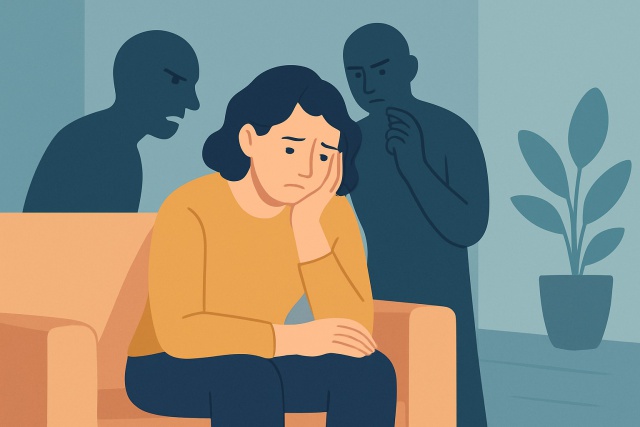
Language Processing Disorder - Signs Every Parent Should Know
Language processing disorder impacts how children understand and use language. Learn to recognize ea...
Chronic pain affects millions across the globe and can often feel like a puzzle that is tough to piece together or manage, especially when trying to identify specific chronic pain symptoms. This article explains what chronic pain really means, how to spot its symptoms and explores treatment options.
Chronic pain is a stubborn kind of discomfort that lingers well beyond the usual three to six months you would expect for healing. It just doesn’t know when to quit. Unlike acute pain that usually signals a fresh injury, chronic pain plays by different rules. It arises from complicated changes in the nervous system.
It is a pretty common misconception that chronic pain always means there is lasting tissue damage or that it is simply all in someone's head. Chronic pain is very real and can stick around even when there is no clear physical cause to point to.
Chronic pain symptoms can vary quite a bit from person to person, hitting not just the body but also messing with emotions and thoughts.
Chronic pain can sneak up on you in many ways. Sometimes it sticks stubbornly to one spot like a nagging sore back or joints worn down by arthritis. Other times it’s a widespread nuisance spreading across different areas, similar to what individuals with fibromyalgia often experience. You might also feel numbness or pins and needles that won’t quit. Muscle spasms or cramps tend to show up often, usually triggered by movement or the stress life throws our way.
Living with chronic pain often brings emotional challenges. That constant nagging discomfort can stir up stress and feelings of helplessness as well as bouts of depression or anxiety. I have noticed many people feel isolated because pain limits their social life.
Chronic pain often takes a toll on mental functions by making it tricky to concentrate and causing memory hiccups. It also slows your thinking down.
Chronic pain doesn’t just stick to causing physical discomfort. It quietly chips away at mental and emotional well-being too, reshaping the way people think and feel day in and day out—often without them even realizing it.
Chronic pain usually has a few culprits behind it like injuries that didn’t heal as smoothly as we’d hoped or pesky complications that sometimes pop up after surgery. Then there are chronic conditions such as arthritis that tend to stick around. It can also trace back to nerve damage or illnesses like fibromyalgia and migraines.
A handful of risk factors seem to up the odds of developing chronic pain. Older adults often carry a heavier burden of chronic conditions that bring on pain, and genetics can sneakily influence just how sensitive or tough someone is when it comes to pain. Then there are lifestyle habits all quietly chip away at our resilience.
Diagnosing chronic pain calls for a thorough clinical evaluation where doctors dig into symptom patterns and take a long, hard look at the patient’s medical history. Physical exams zero in on movement and sensitivity, while various tests help rule out other possible culprits.
Diagnosing chronic pain is no walk in the park mainly because we do not have a lab test that can put a number on it. The symptoms are often quite subjective and can shift from day to day, so clinicians have to roll up their sleeves and piece together clues from different angles to get the full picture
Managing chronic pain usually calls for a well-rounded approach that focuses on easing symptoms and boosting quality of life rather than aiming to completely wipe out the pain because that is not always realistic. Treatments often blend medications, physical therapy, psychological support, lifestyle tweaks and sometimes more advanced options. Each is carefully tailored to fit the unique needs of the individual.
When it comes to medications, it is always a bit of a balancing act. Finding the right one can sometimes feel like trying to hit a moving target, but hang in there—it's worth it. Whether you are dealing with daily prescriptions or occasional treatments, understanding what each medication does can make a world of difference. And hey, don’t be shy about asking questions; after all, it’s your health we’re talking about.
Common treatments usually include pain relievers like acetaminophen and NSAIDs that help reduce inflammation. Antidepressants and anticonvulsants often pitch in by managing nerve pain and improving mood. While these meds usually do their job well, side effects can pop up and there’s always a risk of dependency.
When it comes to physical therapy and exercise, it’s not just about moving your body—it’s about finding the right balance that gets you back on your feet without pushing too hard. In my experience, a tailored approach that mixes patience with persistence can really make a world of difference. Sure, it might feel like a slow climb at times, but every small step counts. And hey, sometimes a bit of gentle humor and a good stretch go a long way in keeping motivation alive.
Physical therapy offers personalized exercises tailored to build your strength and improve flexibility. It also helps straighten your posture—little things that can ease nagging pain triggers. Low-impact activities like swimming, walking or yoga are fantastic because they keep you moving and encourage your body to release endorphins, the feel-good chemicals that naturally dull pain. Staying active regularly might sound like a tall order but it is key to preventing muscle loss and physical decline that can worsen chronic pain.
Techniques like cognitive behavioral therapy (CBT) offer patients handy tools to reframe how they think about pain, helping to lift some of that heavy emotional weight that often tags along. Meanwhile, mindfulness and stress reduction practices nudge patients to stay anchored in the present moment.
Making positive lifestyle choices really is the cornerstone when it comes to managing pain. A balanced diet does more than just fill you up—it helps repair tissues and gently dials down inflammation. Quality sleep gives both your body and mind the reboot they need to recover. When stress starts creeping in, using relaxation techniques often works by loosening stubborn muscle knots. Complementary treatments such as acupuncture, massage or chiropractic care often provide relief by boosting circulation and easing muscle stiffness.
When less invasive options just won’t cut it, this is where interventional treatments and surgery step into the spotlight. They’re often the game-changers, tackling problems head-on when other approaches have run their course.
In more extreme cases treatments like nerve blocks or spinal cord stimulators might be on the table. Surgical procedures may also be considered. These options generally step in once gentler conservative approaches have fallen short.

Living well with chronic pain symptoms usually means figuring out how to juggle your symptoms day by day while holding onto a hopeful outlook. Being straightforward with your healthcare providers and building a reliable support network can really boost your quality of life. Learning to pace yourself also helps.
Managing chronic pain is something that really takes time and a steady hand. I have found that those small, consistent steps—like the ones you might almost overlook—often add up to a noticeable difference and can gently nudge things in a better direction over time.
Your pain is absolutely real. Chronic pain often comes from changes in how your nervous system processes pain signals rather than ongoing tissue damage you can see on a scan. So a 'normal' result doesn’t mean your experience isn’t valid or that it’s all in your head. It’s common for pain to persist because of nerve sensitivity or changes in how your brain interprets pain—things that usually don’t show up on typical imaging.
Treating chronic pain isn’t a sprint. It’s more like a marathon. Some medications might provide relief within days or weeks which can feel like a breath of fresh air. But real lasting improvements from physical therapy and lifestyle changes often take several weeks to a few months with consistent effort. The goal is steady progress in how you function and manage pain rather than a magic switch.
When a flare-up occurs, resting is your best option along with any prescribed 'rescue' medications if you have them available. Gentle methods like deep breathing, meditation or a simple hot or cold pack can help ease the discomfort. It’s important to avoid pushing through the pain because that usually backfires and makes things worse. Once the worst is over, pacing your activities helps you recover more smoothly.
Because of risks like dependence and side effects, opioids are generally not the first choice for chronic pain nowadays. Doctors usually recommend a combination of physical therapy, non-opioid medications such as NSAIDs or certain antidepressants and psychological therapies. This approach tends to be safer and more effective for managing pain long-term.
When your brain constantly processes pain signals, it’s like running a mental marathon—it consumes a lot of energy and cognitive resources. This leaves less capacity for focus, memory and quick thinking. So the 'brain fog' you experience is really your nervous system being overloaded not a sign of another hidden problem.

Language processing disorder impacts how children understand and use language. Learn to recognize ea...

Quiet borderline personality disorder is a hidden form of BPD marked by intense internal struggles....

Discover key signs of self defeating personality disorder and understand its psychological roots. Le...

Discover how malingering and factitious disorder differ fundamentally in motivation and clinical pre...